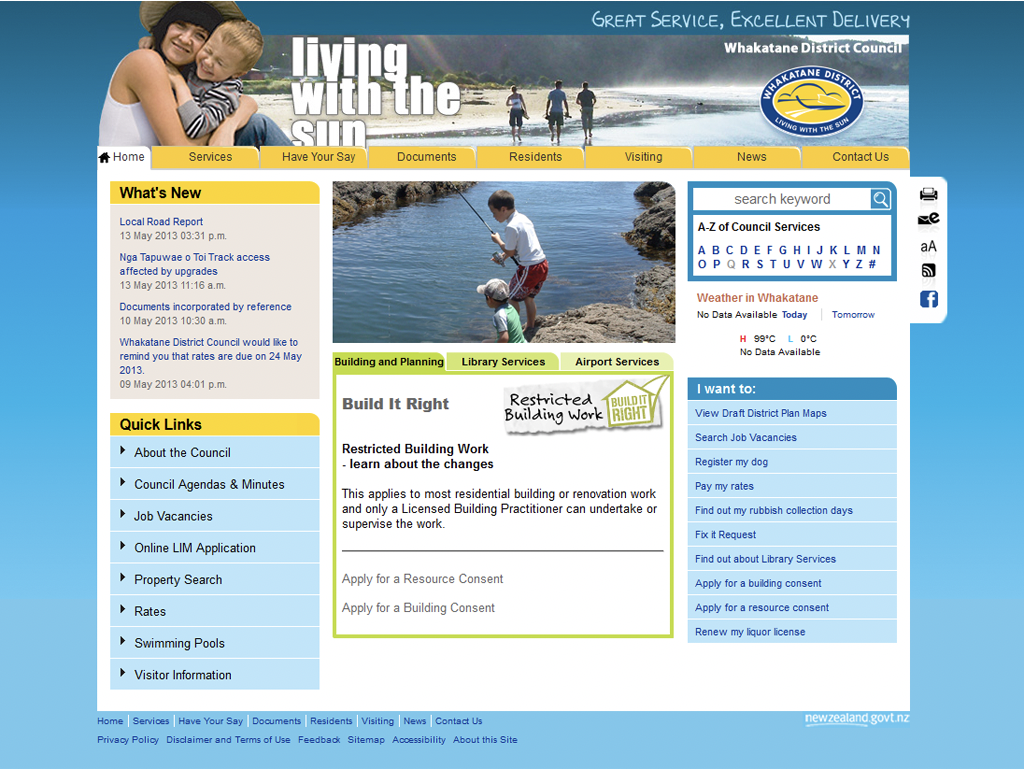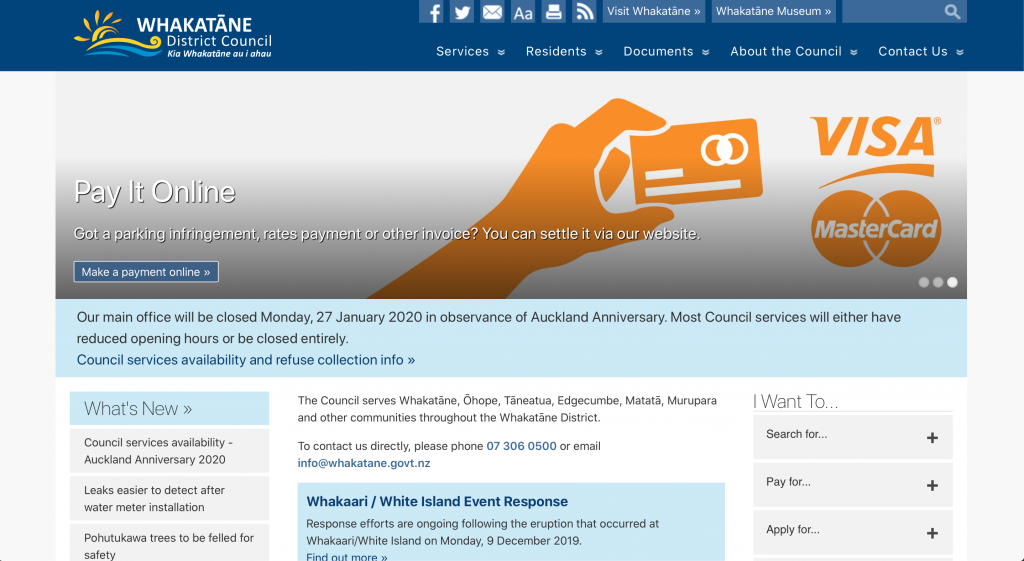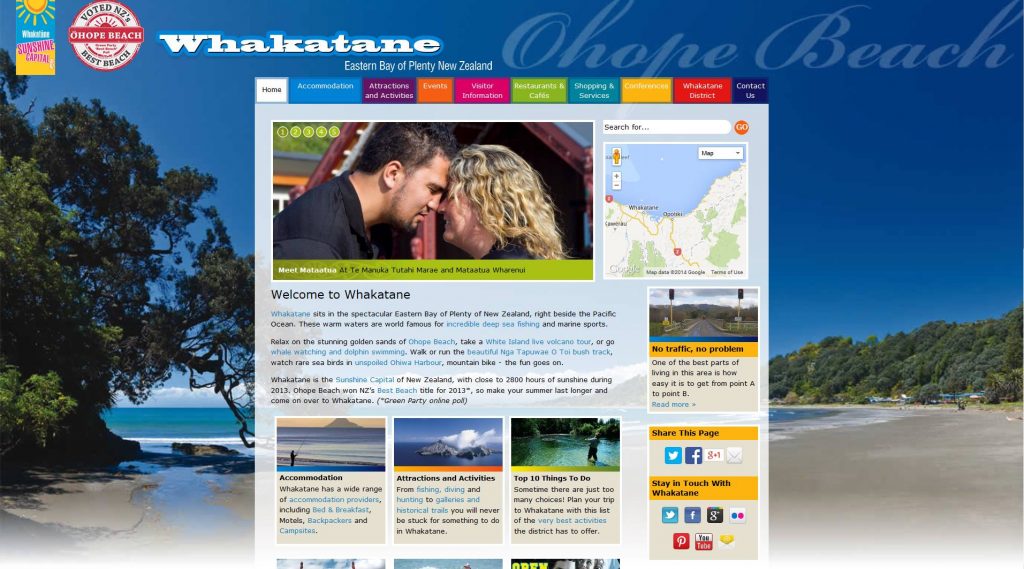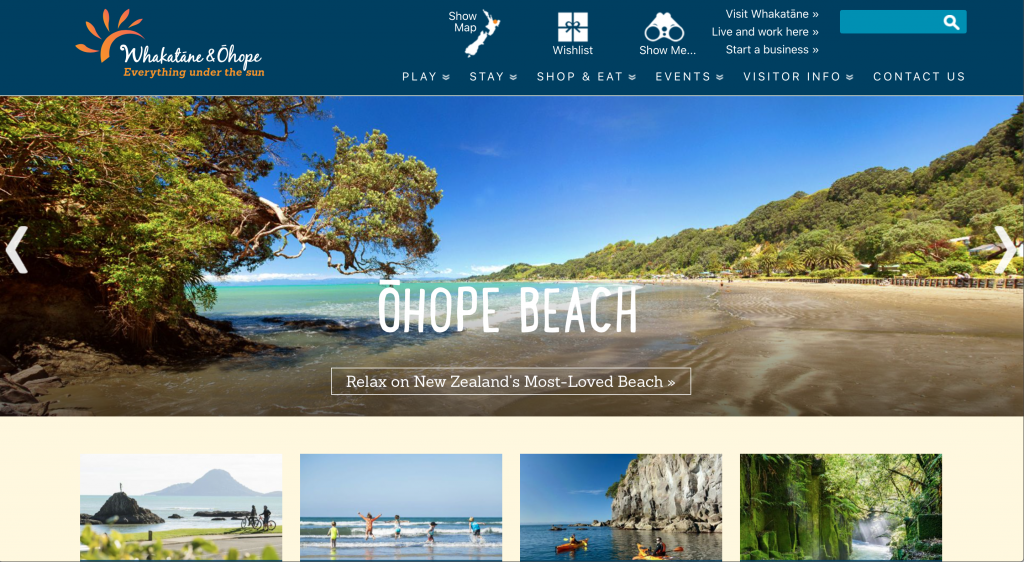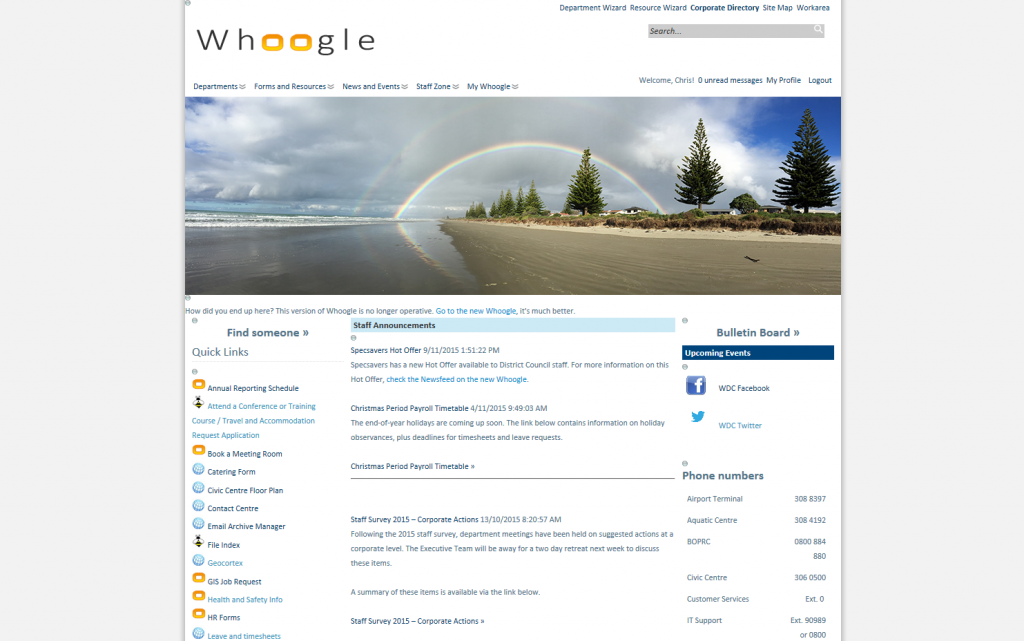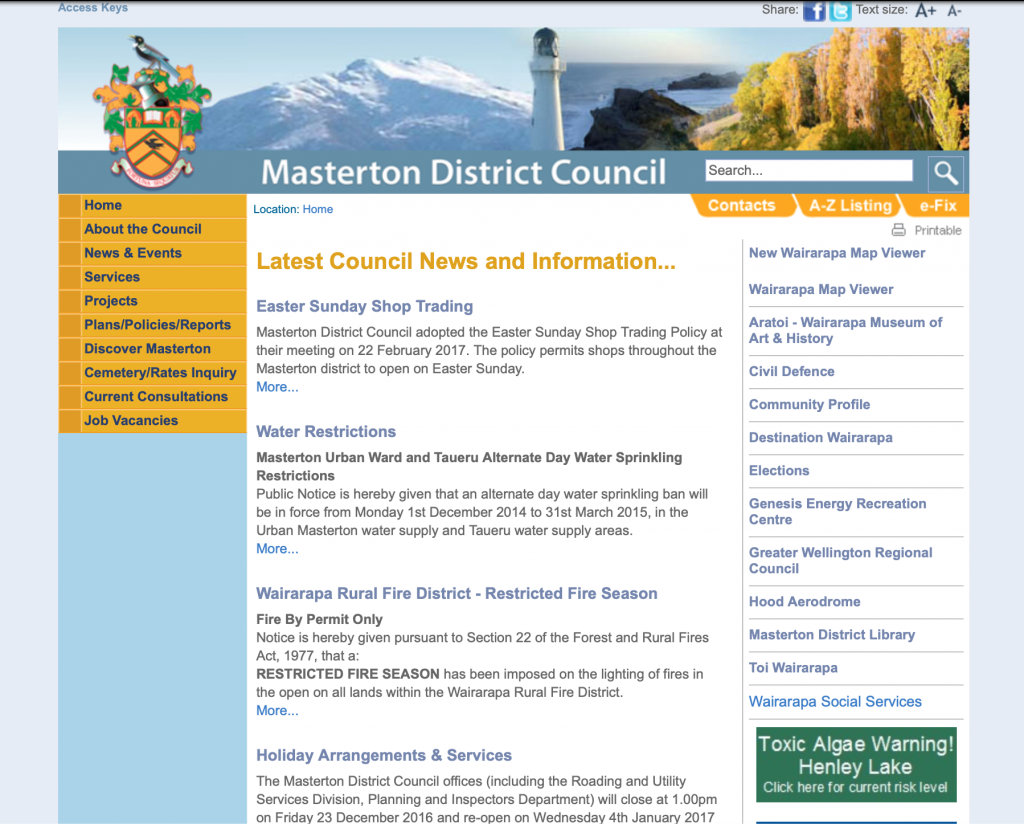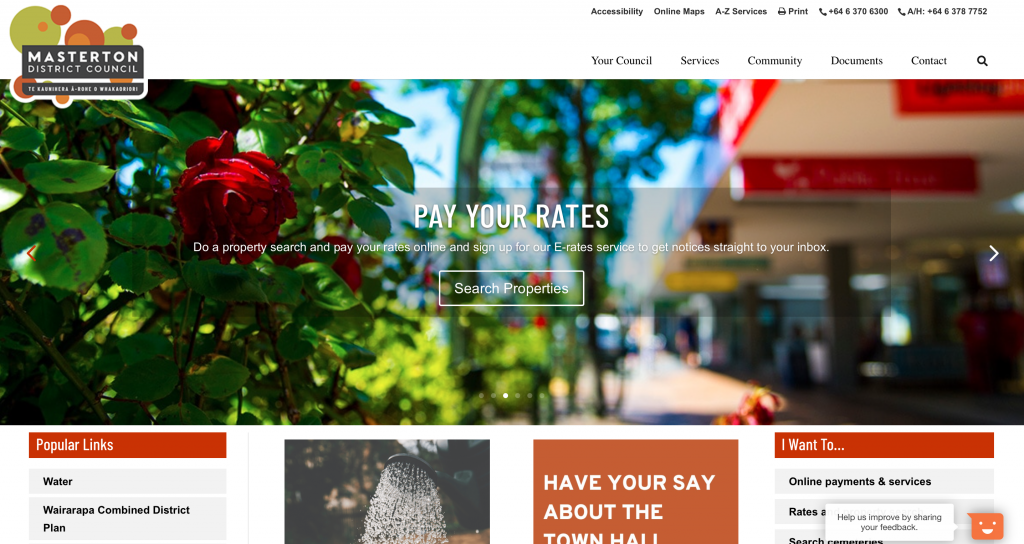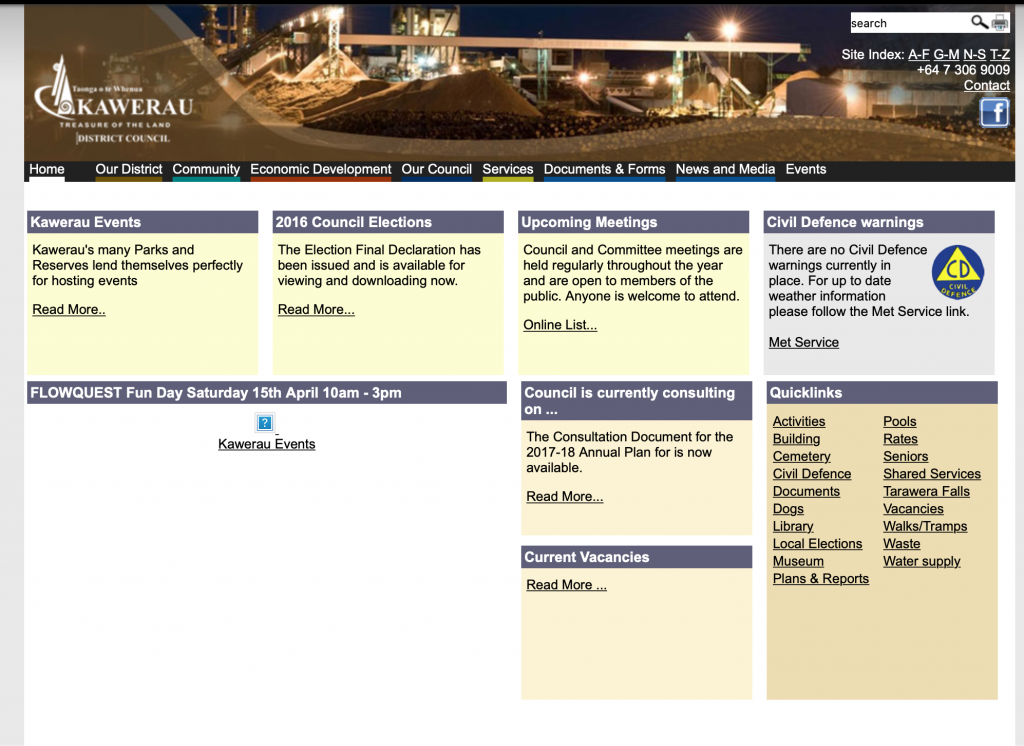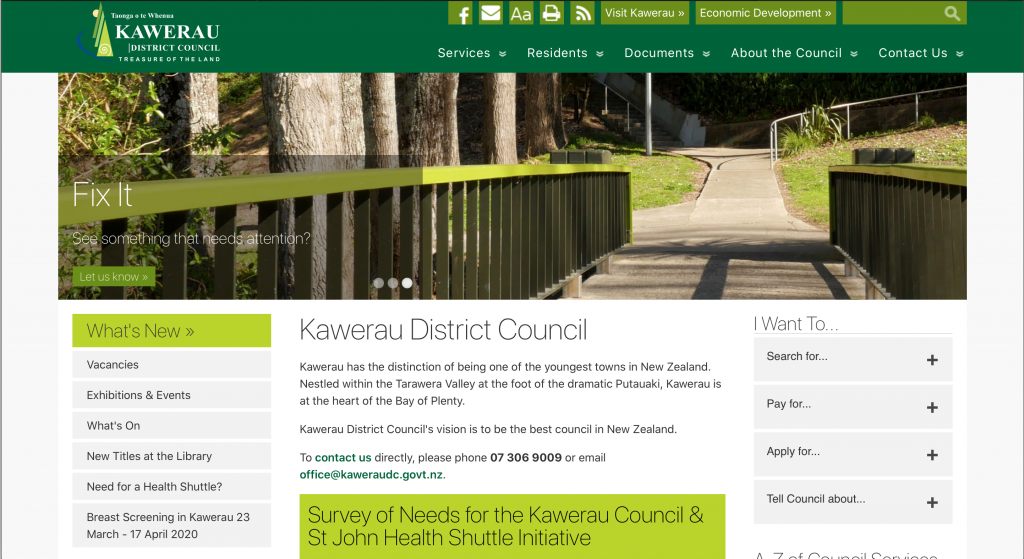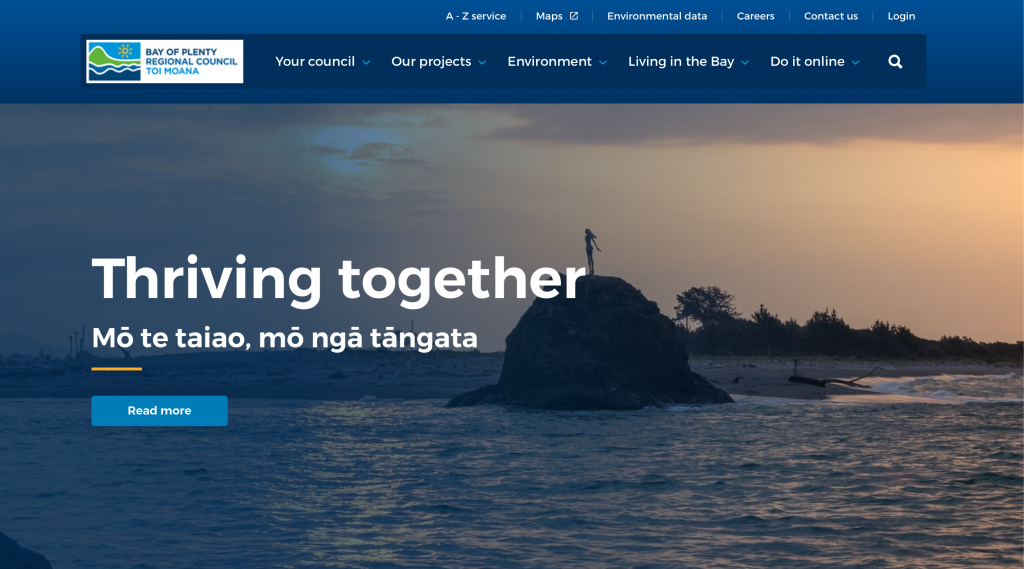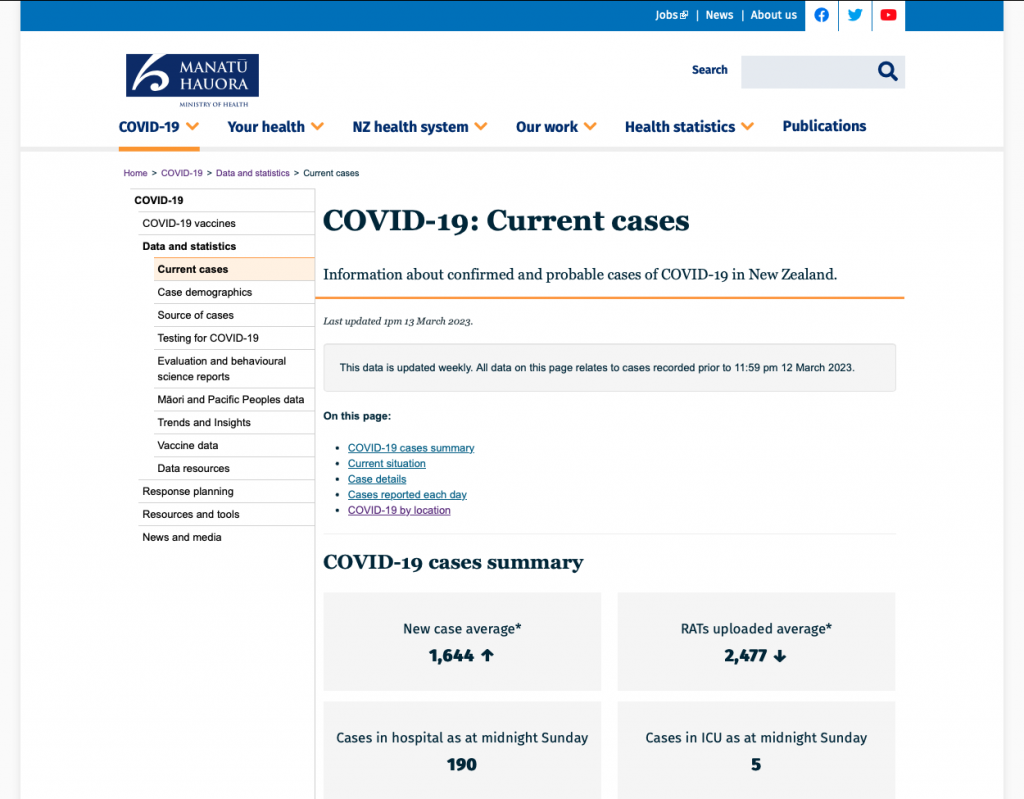I’ve been at the head of several major website redesign projects over the past 10 years. Overviews of some of these projects are available below.
If you want more detail about any of these projects, or you’d like to talk about a similar project, feel free to contact me.
Redesign and rebuild of whakatane.govt.nz — 2013
The website for Whakatāne District Council offers information and services for approximately 40,000 residents and ratepayers in this largely rural area of New Zealand’s Bay of Plenty region.
The website’s last redesign took place in 2009, and its content was managed on an outdated version of EpiServer. Aside from a basic property search function (which relied on manual, weekly uploads of a CSV file containing the entire property database), the website offered no interactive online services.
Like most .govt websites of its era, it had a desktop-only design that was not responsive for mobile devices.
The 2013 Association of Local Government Information Management (ALGIM) survey of local authority websites in New Zealand ranked whakatane.govt.nz 25th out of 78 websites.
I redesigned this website from the ground up, with wireframes produced by July 2013 and a final design brief produced in collaboration with our in-house graphic designer by September.
An external web development agency built the website on a completely new platform, using open source Drupal as a content management system. I worked closely with the agency to ensure the website met its design goals, including a fully responsive design for smartphones, tablets, and desktops, plus strict adherence to AA-level WCAG 2.0 guidelines.
I guided the collaboration between the Council’s customer services and IT teams and the external developers to produce a range of online services for the website. At launch, this included real-time access to the Council’s property info database, plus online payment facilities for property rates and parking infringements. More online services followed later, including online dog registration.
The website launched one week ahead of schedule in early December 2013, with a total development cost of $25,000.
ALGIM’s 2014 survey ranked whakatane.govt.nz 3rd of 78 websites, a climb up from 25th in the previous year. From 2015 through 2018, ALGIM ranked whakatane.govt.nz 1st out of all 78 local government websites in New Zealand.
As of 2023, the design remains essentially the same as its 2013 redesign — a testament to the long-term thinking behind this project.
Redesign and rebuild of whakatane.com — 2014
Whakatāne District Council owns and maintains this tourism-focused website, designed to draw both international and domestic visitors to sample what the area has to offer.
This website’s last redesign was in 2010. Like many websites built in that era, rather than having a responsive design for mobile devices, it instead had a separate (and extremely basic) m.whakatane.com website for smartphone users.
This older version of the website had very small images — too small to see clearly on most mobile devices. The site’s text also wasn’t optimised for online visitors; for example, some attraction pages had many thousands of words worth of text. That’s workable for a tourism magazine, but it’s not the ideal approach for a tourism website.
The combination of a writing style that didn’t suit the medium, much too small images, and less than ideal information architecture led to very high bounce rates (in excess of 60%) and very low user engagement with the site.
My redesign of the tourism website launched in late 2014. It featured a complete overhaul of the information architecture, hundreds of new high-resolution images, and a fully responsive design with breakpoints ranging from the smallest smartphones all the way up to HDTVs.
I stripped the site’s writing down to the bare essentials, insisting that wherever possible we should use photographs of the District’s beautiful vistas and attractions to tell their stories rather than huge reams of text that our mostly-mobile audience wasn’t going to read.
Following the launch of the redesigned website, bounce rates dropped from 60% to less than 15%.
To save time and keep development costs as low as reasonably achievable, I worked with the same external developer agency as for the whakatane.govt.nz website redesign in 2013. We re-purposed the underlying framework of the Whakatāne District Council website for this project, which not only paid huge dividends in development efficiency but also allowed us to easily maintain continuity of branding across multiple Council-managed websites. This redesign project launched after a total capital expenditure of about $9000.
This website was redesigned once again in 2019. My involvement on that project was limited to early-stage production of website wireframes and an overall design brief, much of which made it into the final design.
Complete rebuild of Whakatāne District Council intranet — 2015
The Council’s existing intranet, called “Whoogle”, had been built in 2011. It was built on a proprietary CMS with an extremely convoluted, error-prone interface that staff didn’t understand how to use. Because no one knew how to use the CMS, most of the intranet’s content was years out of date. And because most of the content was out of date, no one in the organisation really trusted Whoogle as a source of accurate information.
The existing CMS for the intranet wasn’t scalable or even sustainable for what the organisation needed it to do, so there was no question of whether we would retain it (or use an updated version from the same vendor). The real question was instead what CMS we would use to replace the one we were using at the time.
In the end, it came down to two choices: Drupal (because that’s what we were using for all our public-facing websites) or SharePoint (because that’s what everyone else in the world uses for their intranets).
In the end, we went with SharePoint. This was the right choice, though there were quite a few challenges just getting the project going.
This was back in the pre-Office-365 days when on-premises SharePoint was still a thing, so our in-house ICT contractors had to spend a couple months spinning up a usable instance. Once that was done, I spent six months creating a site collection, implementing a responsive design for mobile devices to future-proof the site, and porting all the content and documents over from the old version of Whoogle by hand, by myself. I started the work in earnest in April 2015, and I was pretty much done with the bulk of it by October.
I opened the new intranet for a two-month beta test limited to select invitees, then did a second beta open to all staff. Following that, the new intranet went live in December 2015, 10 months after the project started. Total capital expenditure on this project was $0, and only three staff members had any involvement in the development: two ICT contractors who created the SharePoint farm; and me, who did literally everything else from design to content to implementation.
Initial feedback from staff was almost universally positive, not least because one of the main goals of the project had been to democratise the intranet. I used SharePoint’s built-in Newsfeed feature (which Microsoft later replaced with Yammer) to give staff ways to communicate with one another that they hadn’t had before. I also gave all staff open access to view and edit everything on the intranet, made simpler by putting most pre-existing content into an intranet wiki that I called Whakapedia.
Training users how to use SharePoint was extremely simple compared to the previous CMS; most staff didn’t need more detailed editing instructions beyond, “Do what you’d do when editing a Word document.”
The end result was a much more user-friendly, usable, and trusted source of information for the Council.
Website rebuild consultation: Masterton District Council — 2017
Masterton’s existing website, mstn.govt.nz, consistently ranked toward the bottom of the ALGIM rankings because of its dated design, lack of online services, and insufficient flexibility in its underlying CMS to allow easy updating of website information. They wanted to provide better information and services to the residents of their District, and since Whakatāne District Council had been the top-ranked local government website in New Zealand for two years in a row at that point, they figured we were well-positioned to help them improve.
In early 2017, Masterton District Council’s communications manager approached my manager at Whakatāne District Council about a knowledge-sharing partnership, with the intention of using any insights I could provide to inform a rebuild of Masterton’s website.
The result of those early discussions was an agreement to fly me down from Whakatāne to Masterton for an in-person consultation with Council staff and the web development agency they had been working with on their in-progress website redesign project.
Before I flew down, I evaluated their existing public website, and I got access to their in-progress rebuild. I took copious notes on both to help me prepare for the array of meetings I would have later on.
Largely because of the breadth and depth of the detail I went into in my notes, the comms manager would later comment that he felt they’d made more progress on the website rebuild project during the two days I spent in Masterton than had been made in the preceding six months.
I was able to identify gaps in the rebuild project, particularly with respect to web accessibility standards, and I communicated these to both Masterton’s comms team and the development agency they’d been working with.
Following my two-day consultation in Masterton, the teams worked together to deliver a totally rebuilt website later that year. It climbed much higher in the annual ALGIM rankings, but more importantly, the new website delivered much more easily accessible information and services to the 29,000 people living within the district.
Website rebuild consultation: Kawerau District Council — 2018
As the smallest Council in New Zealand, both in terms of area and population, Kawerau District Council doesn’t have much to lean on when it comes to resources. Its website was reflective of that in many ways — with a design more than 10 years out of date and no online services to speak of, kaweraudc.govt.nz was consistently at or near the bottom of the annual ALGIM rankings of New Zealand’s local government websites.
Without the financial or staffing resources of larger (or even most smaller) councils, Kawerau couldn’t hope to redesign its website on its own, and it couldn’t afford to pay someone else to do it either. Maintaining the status quo of an ancient website that didn’t serve the needs of its residents or ratepayers wasn’t an option either.
At the time, Whakatāne District Council was using a web hosting service called Aegir that allowed us to create “clones” of websites on the fly. These were bit-for-bit duplicates of our live site that we usually used as easily disposable testbeds for design projects, UAT testing of major updates to backend modules, and the like.
An idea hit me: why not create a duplicate of our website and let Kawerau populate the clone with their own content and branding?
That’s exactly the idea we pitched to Kawerau District Council in late 2017. Whakatāne District Council, working in concert with its web hosting agency, would create a complete clone of whakatane.govt.nz. Kawerau District Council could then access that cloned website, remove all of Whakatāne’s content from it, repopulate the website with Kawerau’s content, and apply some styling changes in CSS to get Kawerau’s branding in place.
Once Kawerau finished loading its content onto the clone site, the web hosting agency would publish the website, now associated with Kawerau’s pre-existing website address — and at the flip of a switch, Kawerau’s website would jump more than 10 years ahead in a single day, at next to zero cost.
Kawerau agreed to pursue this idea, and the project went ahead swiftly.
The new website launched in 2018 and delivered a vastly superior experience to the residents and ratepayers of Kawerau.
Website rebuild consultation: Bay of Plenty Regional Council — 2018
The surest sign of a satisfied customer? Repeat business. The former comms manager for Masterton District Council was now the comms manager for Bay of Plenty Regional Council, and when the time came for BoPRC to redesign its website, he brought me in for a one-day consultation for the project.
The setup was very similar to the Masterton District Council project: I identified weaknesses and gaps in functionality on BoPRC’s existing website, made recommendations for improvements to web accessibility, and made them aware of the kinds of existing services the Council offered in-person that it could also offer digitally on its website.
Although I was only involved in the project during a one-day in-person consult with BoPRC staff and their external developer agency, the recommendations I made helped the Council’s 2019 website redesign unseat Whakatāne District Council from the top spot in the ALGIM rankings for the first time since 2015 — now boprc.govt.nz was the top-ranked local government website in New Zealand.
COVID-19 data presentation: Ministry of Health — 2020
I began working for the Ministry of Health at the start of New Zealand’s response to the COVID-19 pandemic. While I was initially brought on to assist with managing content related to COVID-19, I soon took over primary responsibility for daily updates of COVID-19 case data.
The original process for updating this data was highly manual and extremely error-prone. Updating the case data pages with data supplied to us usually took between 90 minutes to two hours every day, which often resulted in delays publishing the data. Worse, because the process was so easy to get wrong, the published data contained errors far more often than was ideal.
In August 2020, our team was supplied with a design brief of an intended overhaul of the presentation of data on these pages. The team that had produced this design brief hadn’t consulted with us beforehand, so I had to translate what we were given into something that would actually work from the perspective of proper, audience-focused data presentation on the website.
At the same time, I was able to collaborate with the team producing the case data outputs and came up with a solution that took almost all of the manual updating out of the process. With the new case data uploading process now around 90 percent automated, the time needed to update the data on the website went from its original 90 to 120 minutes per day down to 15. The new process also significantly curtailed the possibility of publishing erroneous data.
The new data presentation and uploading process made it much easier for New Zealanders to understand the current state of the pandemic, which greately enhanced our country’s response to COVID-19.

